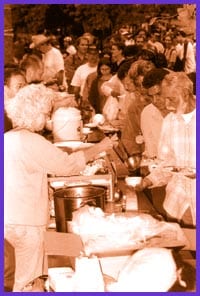Business owners in Vancouver’s gay neighbourhood want to push panhandlers right out.
“We know that most people on the street suffer from drug or alcohol addictions,” reads the pamphlet, produced by the Davie Street Business Improvement Association (BIA). “Your loose change only feeds their addiction. Don’t be fooled by signs saying they want food and shelter. There are agencies that provide free meals and shelter every day.”
The pamphlet advises businesses and people to give that money to social service agencies and charities, instead of to people.
The campaign is borrowed from ones conducted in nearby Vancouver neighbourhoods (the Robson St, Gastown and Downtown Vancouver business associations).
The tactic is common to many urban centres in dealing with panhandlers. But those who work with street youth are disappointed to see it applied by an association spearheaded by gay businesses.
Kelly Wolfslehner, of The Youthco AIDS Society, a peer-driven service agency, says she’s pleased the BIA is encouraging street people to access social services.
But giving money to organizations – and not people – makes it less certain you know where your money is going, she says.
“What’s happening here is disenfranchising youth even more,” Wolfslehner says. “Not only do you say no to giving them money, but you avoid face-to-face contact.”
(If you’re not careful, you may end up donating money to a group that won’t help solve the problem, either. Some agencies concentrate on adult clients. Others, like the Salvation Army, have religious objections to homosexuality, while others, like Covenant House, prohibit safe-sex information on their premises.)
Wolfslehner also says the language assumes a connection between panhandling and substance abuse. And the pamphlet fails to take into account that education, language and even sexuality play a role in why people, especially youth, end up on the street.
Lawyer Ken Smith, last year’s chair of the Vancouver Gay And Lesbian Business Association, cites other factors besides drugs that put people on the street.
“The only comment I’m prepared to make is it doesn’t account for the number of people on the street that are mentally and emotionally disabled.”
A 1999 newsletter of the Gay And Lesbian Business Association informed member businesses that panhandling was “out of control” on Davie, providing a how-to guide to getting rid of panhandlers as well as stories of them taking in $150 a day.
And the chair of the Davie BIA – founded last February specifically in order to get rid of panhandlers – rejects criticisms. Vince Connors says the pamphlet is just part of the overall strategy which, in conjunction with the Vancouver Recovery Club, hopes to give people options other than of panhandling.
“These people have full access to food, clothing, shelter, medical drugs and education,” says Connors. “They absolutely don’t need a penny from passers-by.”
A 1994 adolescent health survey by The McCreary Centre Society found that 67 percent of male and 40 percent of female street youth surveyed in Vancouver described themselves as “completely heterosexual.”
Twenty-three percent of young women surveyed identify as bisexual, and four percent as lesbian. For young males the numbers are 11 percent bisexual and six percent gay.

 Why you can trust Xtra
Why you can trust Xtra


